In the studio
I remember saying to George Martin, ‘I want a very clean recording.’ I was into clean sounds – maybe a Beach Boys influence at that point.
The recording of ‘Penny Lane’ began on 29 December 1966. Initially working alone, Paul McCartney recorded six takes of piano chords to form the song’s basis, onto track one of the tape.
He then overdubbed another piano part onto track two, fed through a Vox amplifier with a tremolo effect at a low speed, while Ringo Starr simultaneously added a tambourine part.
McCartney added more piano onto track three, using EMI’s ‘Mrs Mills’ honky-tonk piano. He also recorded some high harmonium notes, fed through a guitar amplifier, onto track four. At this stage all four tracks of the multitrack tape were full. The instrumental work-in-progress can be heard on the 2017 Special Collector’s Anniversary Edition of Sgt Pepper’s Lonely Hearts Club Band.
The following day, 30 December, a reduction mix was made which moved all the recordings thus far onto track one. This was known as take seven. McCartney and John Lennon then recorded vocals, with the tape machine running slightly slower than normal, at 47.5 cycles per second, so it sounded faster upon playback.
The Beatles returned to ‘Penny Lane’ on 4 January 1967. McCartney recorded more lead vocals onto track three, and Lennon played piano and George Harrison added lead guitar to track two. Both these tracks were unused.
McCartney redid his vocals the following day, 5 January, on track three, with additional vocals from Lennon.
On 6 January drums, congas, electric guitar and bass guitar were added to track two, again with the tape machine running slow at 47.5 cycles per second. A reduction mix was then made – take eight – with instruments moved to track one and vocals to track four, leaving a further two tracks for the remaining overdubs.
The first brass overdub was on 9 January: four flutes, two trumpets, two piccolos and a flugelhorn. The following day The Beatles added harmony vocals, and the ringing of a handbell whenever the fireman or his engine appeared in the lyrics.
On 12 January two trumpets, oboes, cor anglais and a double bass were overdubbed. ‘Penny Lane’ was then left until 17 January, when the final touch was added. This was the song’s distinctive piccolo trumpet part, played by David Mason, whom McCartney had seen performing Bach’s Brandenburg Concerto on BBC Two on 11 January.
Mason was paid £27 10s for his work which, in the absence of any prepared notation, he helped McCartney and Martin write and arrange.
We spent three hours working it out. Paul sang the parts he wanted, George Martin wrote them out, I tried them. But the actual recording was done quite quickly.
The Complete Beatles Recording Sessions, Mark Lewisohn
Mason recorded two overdubs, the solo, and the flourish towards the song’s close which appeared on early US pressings of the single (and later on Anthology 2). And with that, recording on ‘Penny Lane’ was complete.
Although Paul seemed to be in charge, and I was the only one playing, the other three Beatles were there too. They all had funny clothes on, candy-striped trousers, floppy yellow bow ties etc. I asked Paul if they’d been filming because it really looked like they had just come off a film set. John Lennon interjected: ‘Oh no mate, we always dress like this!’
The Complete Beatles Recording Sessions, Mark Lewisohn
Chart success
‘Penny Lane’/‘Strawberry Fields Forever’ was released on 13 February 1967 in the USA, and on 17 February 1967 in the UK. In Britain it was housed in a limited edition picture sleeve, unusual in the 1960s.
The only reason that ‘Strawberry Fields Forever’ and ‘Penny Lane’ didn’t go onto the new album was a feeling that if we issued a single, it shouldn’t go onto an album. That was a crazy idea, and I’m afraid I was partly responsible. It’s nonsense these days, but in those days it was an aspect that we’d try to give the public value for money.The idea of a double a-side came from me and Brian, really. Brian was desperate to recover popularity, and so we wanted to make sure that we had a marvellous seller. He came to me and said, ‘I must have a really great single. What have you got?’ I said, ‘Well, I’ve got three tracks – and two of them are the best tracks they’ve ever made. We could put the two together and make a smashing single.’ We did, and it was a smashing single – but it was also a dreadful mistake. We would have sold far more and got higher up the charts if we had issued one of those with, say, ‘When I’m Sixty-Four’ on the back.
Remarkably, although it was arguably The Beatles’ strongest single, it failed to top the UK singles chart. Although sales were on a par with other Beatles singles, and it received much airplay across radio stations, it was held off by Engelbert Humperdinck’s ‘Release Me’. It did, however, top the charts in the US and most other countries in which it was issued.
It was pretty bad, wasn’t it, that Engelbert Humperdinck stopped ‘Strawberry Fields Forever’ from getting to number one? But I don’t think it was a worry. At first, we wanted to have good chart positions, but then I think we started taking it for granted. It might have been a bit of a shock being number two – but then again, there were always so many different charts that you could be number two in one chart and number one in another.
Several versions of ‘Penny Lane’ were included in the 2017 deluxe reissue of Sgt Pepper. They were: Take six (instrumental); vocal overdubs and speech, containing suggestions for the brass parts; a new stereo mix; the original mono mix; and the Capitol Records mono US promo mix.

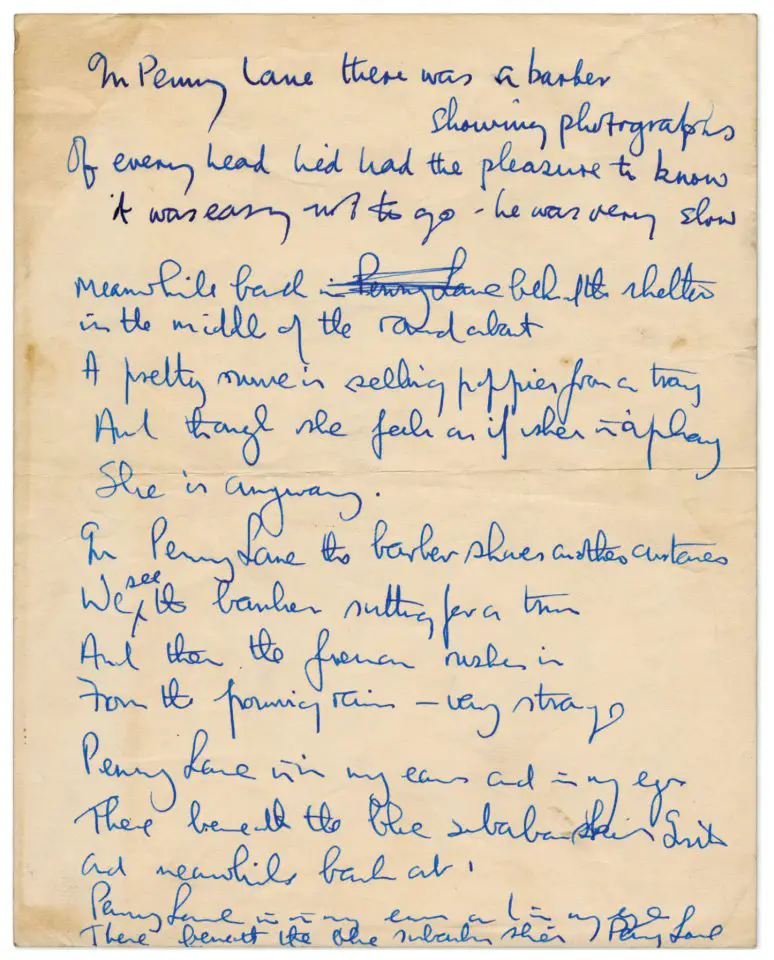
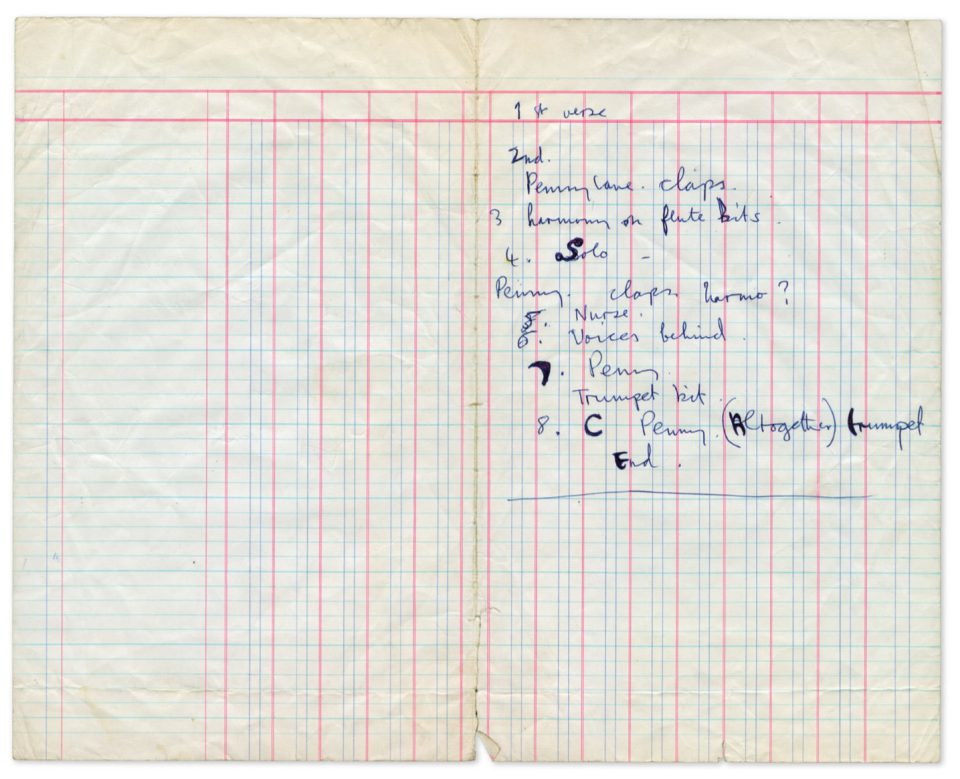
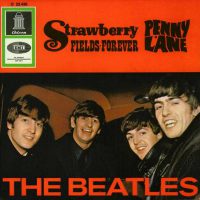
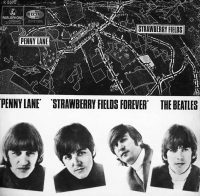
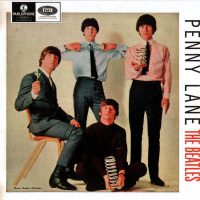
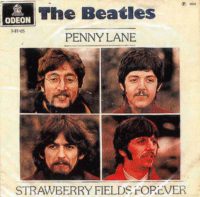
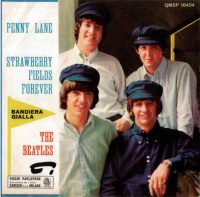
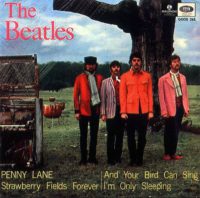

Where can we hear Penny Lane with the original trumpet ending ?
Hi Barbara. Have a listen to the mix on Anthology 2 – it can be heard at the end of that.
You can also hear it on the version released on Capitol’s “Rarities” LP, released sometime in the seventies.
Capitol Records also added it to the version on the Rarities album, which according to the album liner notes, was also the first release of the song in true stereo.
it isn’t a trumpet
Yes it is. A Piccolo Trumpet.
You’re absolutely right. A piccolo trumpet. I have a recording of it on an audio cassette. I would love to get a digital version.
I’m not ENTIRELY sure, but i thought that the piccolo trumpet ending was on one of the final tracks of the SGT PEPPER 50th ANNIVERSARY release? I could be wrong, but it was the first time i heard it (i was born WAY WAY WAY after the Beatles broke up)
Um excuse me how was the cymbal part recorded? I mean if you um mind my asking
Been trying to get it figured out. It is because I am trying to have a borrowed piece I trying to reconstruct that sound.
As Joe mentioned above – it’s on Anthology 2.
ill have to go back and have a look at that! when i went through all the Anthology albums during lock-down I hadn’t noticed! thanks I’ll go back and check. i always thought the Capitol Records Mono Mix was only on the 50th Anniversary edition of Sgt Pepper thanks alot!
Paul’s bass playing brilliance at it’s best. The note selection is just incredible. Ranks in my book as one of the best pop tunes ever recorded. It’s right up there with God Only Knows by Brian Wilson. For anyone studying melody construction, there is much to learn from this composition. I will never ever get tired of hearing this song.
You’re right, Phil, about the bass. Paul remains the only true “lead bass” player in pop music.
“Pop’ music…okay, then. Your comment holds water, I’d say. Roger Waters and Steven Kilbey immediately “popped” into my mind when I read your entry.
Add John Entwistle to that list..
John E was the first lead bassist. Listen to My Generation 1965
Gotta add John McVie to the short list.
Steve Kilbey from the Church? He’s marvellous – but unarguably influenced by The Beatles. Many of the Church’s tracks are Beatles-like – and that is no insult…obviously. I feel I must also add that Paul did for the bass what no other man had ever done for the bass guitar in the pop/rock genre – he brought it to the forefront, driving the melody with such taste and beauty – it’s why I came to love bands like The Police, The Church and Duran Duran (John Taylor is brilliant) and it’s also why early 80’s music is so special: so many heavy bass lines.
Roger Waters was the best composer and lyricist in Pink Floyd, but he never was a very good instrumentalist. David Gilmour often helped him out with the more complex bass parts.
‘Penny Lane’ to all those growing up in the 60’s, this ‘was’ the way we saw life in our own small comunities. We had a girl living down the block named, ‘Penny’, who just loved this song! How wonderful we thought for a ‘Musical Group’ to write such an ‘every person’ song to fit all places, for all times! Such we’re ‘The Beatles’, true heros’ to a young generation in search of their ‘Voice’. Thank You, Beatles,…Forever!
does anyone know where to find the archway in knole park that the beatles rode through? and what about John Entwistle for a lead bass player in a pop band?
Paul was easily the most prominent bass player in pop music at the time with John Entwistle of the Who and Rick Danko of the Band as the closest competition, in my opinion.
(By the way, I thoroughly recommend Entwistle’s first solo album “Smash Your Head Against The Wall”!).
Of course there were other bass players at the time that were consistently solid (especially Bill Wyman of the Rolling Stones and Pete Quaife of the Kinks).
Don’t see how Rick Danko could really be called prominent in 1967 – a handful of unbilled appearances on Bob Dylan singles would be his only contribution to the pop charts. James Jamerson was the era’s most prominent bassist, aside from Berry Gordy’s keeping him totally anonymous.
Danko did not have to appear on the pop charts to be a prominent bass player prior to 1968. His work with Dylan on the 1966 world tour speaks for itself.
Sonny Boy Williamson was going to collaborate with the Hawks prior to his untimely death in the mid-sixties.
That is the nature of Danko’s credibility.
Nobody’s questioning his abilities! I guess it’s the word “prominent” we’re interpreting differently.
Yes, obviously we are interpreting differently.
I believe “influential” is a better word, especially for James Jamerson, in relation to his singular inspiration to so many well known bass players.
After all, how could James Jamerson be “the era’s most prominent bassist” and be “totally anonymous” at the same time?
OK: it’s his playing, his sound, his influence that were prominent, and not the man himself, except in retrospect.
I agree with your assessment of James Jameson if he played on Stevie Wonder’s, “I was made to love her”. Incredible bass line.
Carole Kaye played bass on ‘I was Made to Love Her’
Dont forget Jack Bruce
I would add Chris Squire to any list of lead bass players
Carole Kaye and James Jamerson were top of the heap for bass players in the 1960’s – and Kate was a wicked guitarist, as well!
I’ve not written a blog post on the shooting of the Penny Lane video yet, but the archway can be seen here. You can see where the dust path goes under the arch in the middle of the map – the sun is casting a shadow of the arch.
Dont forget Jack Bruce
“Penny Lane there is a fireman with an hourglass
And in his pocket is a portrait of a queen
He likes to keep his fire engine clean
It’s a clean machine”
The English is not my native language. I have found in the Dictionary of the English military slang that “an hourglass” means a thin waist synched by the belt. This would fit better with the character of the Fireman. Can anybody who’s native language is English confirm that?
Not quite. An hourglass is a glass timing device with two chambers and a narrow bit in the middle. There’s a picture and explanation here: https://en.wikipedia.org/wiki/Hourglass
An ‘hourglass figure’ is when a woman has wide hips and a thin waist, and derives from the shape of the hourglass. The fireman in Penny Lane had the timing device in his pocket, not the woman’s figure!
Joe, you are not right. Hour glass in the fireman’s pocket? No, we only know about the portrait of a Queen. But thank you for the explanation based on female body geometry. I like it.
“Penny Lane there is a fireman with an hourglass
AND in his pocket is a portrait of a Queen
He likes to keep his fire engine clean
It’s a clean machine”
I don’t know if anyone is aware of the death of David Mason, the trumpeter who played the famous trumpet solo on Penny Lane. He was 84. When he was called for the recording he was playing for the London Symphonic Orchestra and didn’t know who The Beatles were. Paul had seen him play on TV The Brandemburg Concerto, by Bach. He thought of using a trumpet played in that style, told George Martin about it and this guy was called. There was no written chart for it, so Paul sang the melody he wanted played, Martin wrote, Mason played two takes, and it was done. He got payed $45.00. Although he played for the LSO for 30 years or so, he was most famously known for his part on Penny Lane.
Thank you, Mr. Mason. RIP.
Not heard that story before but love it, im from Penny Lane myself.
Wonderful story, I always wondered who did the horn on that!
I seriously doubt that he didn’t know who The Beatles were as they had been huge stars in Britain for about four years at that point.
And David Mason’s solo was NOT sped up after he recorded it. Some folks thought that it was, but he proved otherwise by playing along with the record! I’m not surprised; My Dad was a studio musician in NYC and LA and these guys and gals can play and sight read anything with little or no rehearsal. BTW, Mr. Mason played the solo on a piccolo trumpet.
And definitely one of the best ever trumpet solos on a pop record. It’s amazing and still gives me chills.
Does anyone where I can find a version of Penny Lane where the trumpet solo is heard in the middle and at the end?
Lovely, beautiful track on every level – one of my fav’s. One of two great McCartney’s Beatle tracks where the lyrics absolutely shine! (My post for “Eleanor Rigby” — regarding the lyrics — pertains here as well:
`Indeed, this track is quite good. Can we safely assume that Lennon’s contribution was rather prodigious, based on the banality of McCartney’s post-1970 lyrics?’).
I love the phrase “suburban skies”. How many rock or pop songs praise the blue skied suburbs, without irony?
Interesting that this is the phrase you mention, because I was 9 years old when Penny Lane came out and I didn’t know what the word “suburban” meant so I asked my mom and learned a new word – thanks Paul!
Don’t like to engage in ‘John vs. Paul’, but permit me a brief comment”:
“Can we safely assume that Lennon’s contribution was rather prodigious, based on the banality of McCartney’s post-1970 lyrics?”
Hmm…Lennon’s post 1970 prodigious lyrics:
‘God is a concept by which we measure our pain…I’ll say it again’
All of ‘Working Class Hero’ from the only middle class Beatle….
‘Imagine there’s no countries
It isn’t hard to do
Nothing to kill or die for
And no religion too…’
‘Beef Jerky, beef jerky, beef jerky’
Yes, Lennon was quite ‘prodigious’!
On ‘Penny Lane’ I’m sure he helped with a line or two…Thanks.
I really don’t want this comments section to become a John v Paul debate, particularly if it encompasses the solo years too. Can we keep the discussion to Penny Lane please?
I understand that Lennon began to write the lyrics, then McCartney wrote the music and finished the lyrics with Lennon.
Per, Penny Lane was Paul Song Written mainly compose by him in his home in London. John did help with a couple of lines on the 3 Verse.
Is there any guitar in the final mix? Can’t hear any, the bass and piano are certainly the most prominent instruments.
I’ve read that there are about ten piano tracks on this song but I can’t hear them. I’d love to hear a deconstruct of this song,
The greatest single ever? No wonder. It’s from the greatest discography ever.
Elvis Costello does a very nice version of Penny Lane at a White House celebration of McCartney, with McCartney’s band. The best part is Master Sgt. Matthew Harding of the Presidential Marine Band absolutely nailing the piccolo trumpet part.
I always wondered, when the chorus bridges back to the vs., does John Lennon sing, “I sit and….” then Paul, “Meanwhile back..” On headphones that’s what I’m hearing. What do you think?
I’ve always wondered the same thing! I’ve never been able to find the isolated vocal tracks to be able to tell.
That’s how I’ve always heard it too, for what it’s worth.
Love the airy feel of this, almost like a summer’s day under blue suburban skies! Of course, there is an explanation for this. No bass drum you see – nothing to root the rhythm. Would love to get the the multitrack of this.
Penny Lane is a “complete song” in that it tells a story in a circular fashion – by returning the verses back to the beginning with a great twist of irony. If only It and Strawberry Fields Forever were originally included on SGT. Pepper…wow. Great combo of songs for a single double-side release. Penny Lanes is a Happy tune that balances the mystery and strangeness of Strawberry Fields Forever – also a personal story for John.
I think it is very interesting to read that Paul wanted this to be “a very clean recording,” because compared to, say, the songs on Rubber Soul, this one sounds much less real and immediate, probably because of the many piano tracks fading in and out and all of the reduction mixes. It distances you from the performance in a very 1967 kind of way. It would be interesting to hear this one with one piano track, one guitar track, one drum track, etc.
That said, this is still one of my very favorite Beatle songs. Maybe one of my three favorite Paul songs (with Eleanor Rigby and Hey Jude) and one of my six favorite Beatle songs overall (with A Day in the Life, I Am the Walrus, and Strawberry Fields). I find it unbelievable that this band was plucking these plums out one after the other.
I believe he meant clean in the sense that all of the instruments and pieces of the song are crisp, clear, and nicely layered almost like a modern song, no rough edges. Not clean in the stripped-down straightforward type of way. He wanted an intricate pop song that sounded bright and full without sounding busy and bloated, something the Beach Boys were doing since 1965 with stuff like California Girls or In the Back of My Mind. Something similar recorded with more modern technology would be something like Sufjan Stevens’ Illinois album.
David Mason, the trumpeter was mentioned.
Geoff Emerick’s book relates how he played an incredibly hard part (out of the range of the instrument) note-perfect, and then after the take, Macca was going to ask him to try again! George M convinced him it was not going to happen…
Does anybody else find the high-pitched sound at the end and right before the bridge especially annoying?
Sure wish that had been kept out of this otherwise fantastic recording!
That sound is from (I think) the first Penny Lane session – December 29th, 1966. One of the tracks from the four-track tape that day featured those high-pitched notes from an accordion along with some cymbals, as you say especially heard at the end. You can isolate it from one of the channels of the surround sound Anthology DVD mix. There’s audio of it somewhere on YouTube, I’ve heard it myself!
Yeah Joe, I think that’s a feedback of an instrument or a mic? They produce the feedback to the pitch of B-note, same key of the last chord of the song. I just don’t how they made it.
the high pitch at the end of the song isn’t feedback, it is one of the flutes holding a note. You can reference the multiple takes where they experimented with the sound….case closed.
If I am not mistaken, Lennon chimes in signing “in summer” and “another customer”….. sure sounds like Paul hands over the signing of those two pieces and it blends in so well you have to listen close to detect that it’s Lennon….. at least that’s what I hear. Anyone know for sure?
The “in summer” part is a very Lennon voice and I cannot unhear it.
“Geoff Emerick’s book relates how he played an incredibly hard part (out of the range of the instrument) note-perfect, and then after the take, Macca was going to ask him to try again! George M convinced him it was not going to happen…”
Are you certain this story pertains to this session? I could have sworn this occurred with a french horn player in a session for McCartney’s song For No One. And iirc, McCartney did say, “that was very good, now could you try it again and see if you could do it a little better?”. George Martin intervened and that was the end of it.
“Where can we hear Penny Lane with the original trumpet ending ?”
Here is a link to a youtube video I found with a US Capitol promotional copy of the single with the alternative trumpet ending.
I’ve got the version of ‘Penny Lane’ with the Oboe/Cor Anglais recorded before Paul saw the Brandenburg Concerto on TV and I have the proper version with the Trumpet at the end aswell. The Oboe one is quite lovely as it is.
I remember it well, the day ‘Penny Lane’ was heard for the first time on the radio. I was 10yo.
Great intense mood. Introducing instruments (piano, flutes and trumpets, great bass, backwards tapes…) Perfect catchy up-tempo and a wonderful lyric with beautiful lines, which put you right in the scene. Still the best song ever made (in my opinion). But it also was a great time for fashion and mustaches. So ‘Penny Lane Forever!’ (my number one; ‘Something’ my number two).
What makes ‘Penny Lane’ give me the shivers right from the start? The fact that it has NO MUSICAL INTRO!!! (only a quarter-of-a-second bass guitar). The singer and the music are making an optimistic statement right on the first note! It makes you happy right away.
Some other songs without intros e.g. ‘Help’, ‘Hey Jude’, ‘Eleanor Rigby’, ‘We Can Work it Out’ (after a half beat) or ‘Hello, Goodbye’, ‘The Long and Winding Road’. Even ‘Paperback Writer’ (a-capella start) does it.
And listen to Beach Boys’ ‘Good Vibrations’ …aaah!
With regards to the no-intro’s: All Paul songs except for “Help!”. Interesting.
A few more non-intro songs; from the The Beatles (White Album) “I Will”, “Julia”, “Yer Blues” (just a few snare beats by Ringo), “Happiness Is A Warm Gun”, Cry Baby Cry”–4 John Songs
A brilliant song. Paul McCartney’s half of the greatest double A side of all time. The promo films for this and “Strawberry Fields Forever” are classics.
I read somewhere that Paul used to sometimes tune his bass a half a tone down to give it a fuller edge.I think he is the one who admitttef to this in the interview.I always assumed he did thus trick on this song to sustain the longer notes and to make them more pronounced.
I would love to hear the multitracks for this song. There’s so much going on that just yesterday, with the new 2015 stereo mix done by Giles Martin, I could hear things I’ve never heard before – congas throughout, and what sounds like a horn making odd flatulence noises (there are several in arbitrary places during the first chorus). There are also weird sounds near where the banker is mentioned, the most prominent being right after the words “waiting for a trim” – it sounds like either a horn or a stab from George’s guitar.
One of the oddest noises in this song I’ve always wondered about is just before the key-change at the end. It sounds like a cross between a motorcycle and a toilet flush. I think I read somewhere that it was the sound of fingers running along the keys of a muted piano. With the new stereo mix, I’ve noticed the same noise (albeit much quieter) in the chorus after the trumpet stereo.
I was 10 when I heard penny lane. I never heard anything like it before. Listening to the music made me feel so good inside it gave me chills. today I played penny lane and my 5 year old granddaughter heard the song and about 1/4 way she said is I love this song.
It’s very interesting that, although the song was supposedly written by Paul, the film focusses on John which makes me think John was a main contributor to the song.
You like re-writing history do you. It is very well documented that it is Paul’s song, just like Strawberry Fields is John’s.
I think John was there at the start because of his glasses. Though out the Song it goes back to the face of John and his glasses. Midpoint it shows John & his glasses and people reflected off those glasses. Nobody else wears glasses except John.
Considering the song’s main composer and vocalist is Paul, I wonder why the solo scenes feature John? Ironically, Paul has more individual scenes in the film for John’s “Strawberry Fields Forever”. Did the Director mix his vocalists up or did John and Paul make a conscious decision to switch roles?
I think John and Paul still thought of themselves as a partnership during this period, so the solo scenes really didn’t matter.
I can never hear any guitar on this, can anyone tell me where it is??
Most of the guitar work is buried in the song, barely audible. It’s best heard in the refrains.
Harrison’s guitar playing can be best heard in the choruses, starting at 0:34 in the first chorus and finishing with a last chord on 0:50 on the word “back”. He strikes a chord at 2:06 as well, before coming in to chorus #3. Lennon’s and Harrison’s guitars may be heard together from 2:43 to 2:50. All in all, the guitars are a little difficult to make out.
The Beatles “top 100 singles” has this at 32, believe it or not. It definitely belongs in the top 5.
XM playing version of Penny Lane sung by Lennon, anyone know where to find that ?
Can anyone imagine a world where Sgt Pepper had both Strawberry Fields and Penny Lane included? Where would we put these two show-stoppers in relation to the the rest of song list?
I’m asking, because I don’t have a clue…. What would you do?
I made a Sgt Pepper playlist on Spotify and put Penny lane between She’s Leaving Home and Kite. I moved fixing a hole to side 2 where it follows Within you without you( instrumental version) and is itself followed by Strawberry Fields then When Im 64. I quite like this sequencing.
Ha 😉 I think everyone has been singing the chorus wrong for all these years 😉 including Paul in his live performances!
In the original single (or should I say original singular), it sure sounds like Paul is singing “Penny Lane is in my ear and in my eye” instead of “”Penny Lane is in my earS and in my eyeS”. I hear this on the Anthology version too. Of course, since Paul’s live performances are plural, I suppose that bit is open to interpretation, eh? Does anyone else hear it like this?
Clearly, it’s meant to be plural. “Penny Lane is in my ears and in my eyes. There, beneath the blue, suburban skies.” “…Four of fish and finger pies.” But even listening to the 2017 remix, both iterations do sound singular.
Paul doesn´t play a harmonium, it´s a mellotron (also used for the guitar intro of “Bungalow Bill”). The Mellotron was made popular by The Moody Blues.
Paul, for an early Wings album, re-wrote the lyrics and re-titled it ‘Denny Laine”, but Laine wanted half the royalties so it was never released.
Very witty.
This site seems to have not been updated to include the recent 50th anniversary boxed sets. Penny Lane is also in the Sgt Pepper 50th…
The street Penny Lane may be renamed because the name can be linked to an 18th Century slave trader, James Penny, who died in 1799. Is it really necessary to rename street names because they may be linked to events that took place about 250 years ago?
i suppose it depends on the circumstances, but if the street wasn’t named after the slave owner, i see no reason to change it? but, then again, I’m Anglo-Saxon, so there are people MUCH more qualified to talk about this than me
I am sure there are many street names that may be linked to the slave trade if you search for them. I am Norwegian, and Norway also had slave traders. In Bergen, the 2nd biggest Norwegian city, there is a borough with the name Møhlenpris. It is named after Jørgen Thor Møhlen, a businessman and a slave trader who lived in the 17th Century. I have never heard anybody demanding any renaming of Møhlenpris.
There was a Danish/Norwegian slave ship called Fredensborg, which sank outside the Norwegian south coast in 1768. In Oslo there is a road called Fredensborgveien (vei = road). If the road name has any connection to the slave ship, I don’t know. I have never heard anybody demanding renaming of that road either.
I’m trying to understand what you mean in your question.
“Is it really necessary to rename street names because they may be linked to events that took place about 250 years ago?”
If you consider that there are many people who find slavery so objectionable that honouring a slave trader in any way today is unacceptable, no matter how respected they may have been at the time, and for whatever reason (philanthropist, patron of the arts, etc. as well as slave trader), then it seems quite reasonable. After all, there’s no natural law that say street names can’t change, other that our innate resistance to change.
Looking at it another way, you may have never heard of someone wanting to change the names of Møhlenpris or Fredensborgveien, but would you be surprised if—hopefully—the vast majority of Norwegians (including you?) would insist on renaming a street or borough named after Vidkun Quisling?
Or are you just referring to the time that has passed? So where would your cut-off date be for not honouring or celebrating someone who is no longer considered to be worthy of the honour? Hopefully longer than 80 or so years 🙂
Either way, renaming Penny Lane doesn’t diminish the song in any way and the street itself would still be there for any fans wanting to visit it. Perhaps a compromise would be to add “formerly known as Penny Lane” to the new street signs in small letters, or even better, a plaque explaining exactly why it was renamed. That way, history wouldn’t be erased, but put into the context of today’s changed attitudes to previously acceptable events that are no longer considered such.
Have a great day!
While still published by current owners of Northern Songs, Sony/ATV Music, it’s the one Northern Song not owned by the company. Robert Holmes a Court, Australian billionaire, and owner of ATV before he sold to Michael Jackson, gave the publishing rights to his daughter, Catherine, making it one of five Lennon/McCartney songs not owned by Sony/ATV Music (the other four being both sides of their first two singles – two of which Paul now has the publishing rights to).
Completely on the off chance, can anyone help with when Paul McCartney was actually writing Penny Lane? My dear grandmother died on 15 December 1966 in Greenbank Road, which forms the southern junction with Penny Lane, and I would love to be able to tell my grandchildren and great grandchildren that Paul was actually writing the song at that very moment. The recording itself was in late December and early January, so it’s just possible. If anyone has any information on the subject, it would be greatly appreciated.
Who played the congas?
does anyone reckon “portrait of the queen” as a one pound note ?